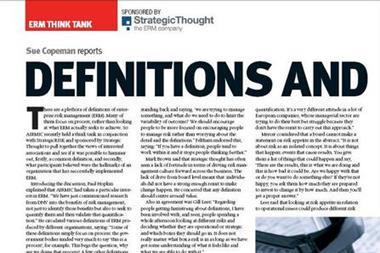Sue Copeman: I think you all agree that models are great but they are tools and you can’t rely solely upon them. So having implemented your model, got your culture change, got your risk based pricing, how do you measure the performance, how do you know how well you are doing?
Giovanni Gentile: First, we need to decide what kind of performance we are measuring – economic, accounting or whatever. With regards to measuring economic performance, are you measuring the economic performance of the whole company or are you trying to measure the economic performance of a certain unit or management? If you measure economic performance at the company level, you really need an economic balance sheet because the economic performance will be the difference between the economic balance sheet in one year and the economic balance sheet in the next. So far, especially on the regulatory front, the focus has been on producing risk capital, basically only a balance sheet view, but actually the economic income side will flow directly from an economic balance sheet assessment. That’s why for performance measurement as well as, of course, for capital, it is very important to have an economic balance sheet before one can measure economic performance. When you then try to measure the performance of different units including capital allocation or attribution, it can be difficult to explain to the guy in a line of business which unfortunately doesn’t get much diversification that he has a very high hurdle to get returns, whereas another line of business which perfectly diversifies has capital for free. So it is not that easy to measure the performance of the manager purely under the capital allocation framework although you can measure the performance of the different units. You probably need some benchmarks too.
Ole Hesselager: It is difficult to decide where to attribute or allocate capital. If you can solve that, in principle the measurement is fairly simple. If you have a transparent process where you have allocated or attributed capital to the business units and you have risk based pricing accordingly, then everything has gone through your management, budgeting and business planning processes. So you really just measure the performance of the business relative to that risk based approach. The hard part is the struggle with the allocation or attribution.
John Redmond: We are talking as if there is a disconnect between the modelling and the business. I think it is important that the business contributes to and influences the modelling process. The whole point of ERM is that you have a holistic approach. It is necessary to enquire whether or not the person who is running a particular business unit, which is part of an ERM process, understands the capital needs as well as, in the case of non-life, the underwriting needs. If the process is established in isolation of the business leaders there is a considerable risk of push-back or, as you said, the business leaders will say that the established model is inappropriate. So if you are going to be serious about this, you had better have the people who are running the businesses as part of ERM.
Tom Wilson: In terms of performance measurement, it is generally accepted that we should focus on shareholder value. There are two schools of thought. One is that earnings are everything in terms of determining your shareholder value and the other one is that value is king. This difference in attitude is divisive and something we need to work on and to talk about with analysts, etc. But the link to shareholder value will be the basis for whatever performance measurement we have.My second observation is that ex ante-performance evaluation in terms of looking forward – should I take this trade or business unit or business line rather than another based on budgets, best estimates, etc – is relatively easy. What is more difficult is ex post-performance evaluation. For example, on a life book if the equity markets are performing favourably, it’s going to be good for you. But how do you distinguish the performance of the business from the good luck that the market has gone up? The only way you are going to disengage that element is to look at other metrics such as competitor performance. Rewarding people for just taking bets that paid off in the short term is probably not the best thing, but as an industry we are not good as disentangling luck and actual performance
Ferdia Byrne: The reality today is that companies have to deal with multiple metrics due to different accounting systems and reporting requirements. Hopefully in the future these will reduce so that there will be convergence between earnings and the value concepts. If you look at where IFRS phase 2 is going, there is reason to be hopeful for a substantial degree of convergence.
Sue Copeman: How does ERM help with enhancing value creation, does anyone have any views here?
Olly Reeves: The ERM framework is quite a good tool for describing how you co-ordinate your overall approach to risk management. It is very hard to measure what value that creates over and above all the individual elements. We are as an industry being very closely looked at by the rating agencies and they are firming up their view on what is good ERM and what isn’t. I think a lot of the value comes from ERM as a communication tool, a means of being transparent about all the activities you have in place and how they knit together in a sound way.
Ole Hesselager: It depends on what you mean by value in this context. Efficient risk management could give me a competitive edge and allow me to create more value for shareholders, but at the expense of someone else. In a sense ERM is changing the competitive environment – we all competing in a different game with more sophisticated, professional rules – but the whole bulk of value is the same. That is one element. From a more high level perspective, the emergence of ERM will hopefully create value for us as an industry in the long run because we will be driving our business in a more solid professional way with fewer defaults and errors and less arbitrary pricing elements. But much of what we do in ERM is probably just shuffling value between competitors.
Jonathan Titman: I would like to distinguish between risk and capital management and value creation. Risk and capital management is where the industry is making significant progress in understanding its portfolio of risks and quantifying those risks through economic capital models. Part of the issue is that that understanding is separated from, say, the corporate finance function that decides on the capital structure of the firm whereas, in reality, the economic capital amount should determine to some degree the capital structure of the firm. What is missing is the linkage back to value and measuring the return on the risk that has been taken and comparing that to the cost of the capital that is backing those risks. In terms of the specifics on how to create value, if you can introduce a framework that acknowledges the role of economic capital in strategic budgeting, reinsurance optimisation, risk based pricing, etc, and optimise around those particular areas, you will be creating value because you are improving the trade-off between the returns you are receiving versus the cost of the capital that you need to back the risks that you are taking. At the moment, I don’t think anyone is really thinking about value compared to the more technical areas.
Sue Copeman: Would anyone disagree or agree with that?
Tom Wilson: I think that distinguishing between measurable value and the value of the role of the risk manager and ERM is interesting. I like to think that in my role and the role of my function we add value on many different dimensions. At the product level it is by making sure that we don’t put long dated products on our books that we are going to regret and, in addition, by not restraining growth but rather promoting a sustainable, profitable growth trajectory for shareholders. So at the product level. the value is balancing growth versus legacy and risk. On a control basis, I like to think I add value because, for example, when the analysts start ringing up and asking what’s our exposure to sub-prime mortgage credit, we have to produce a number relatively quickly to avoid getting tarred with the industry brush. And that number had better be correct because if I have to update it then I’m going to have a discount automatically. So that’s the second level – control and understanding what is in your portfolio. Solvency management requires the ability to measure and manage capital adequacy and to interact with rating agencies and regulators. Based on our understanding, we have too much capital and, as a consequence, ING is currently undertaking a $5bn share buy-back; risk management played a strong role in terms of defining both our available financial resources and our economic capital requirements to show that we could afford this as well as the acquisition of a bank in Turkey. So I added value there. And finally, I can add value just by giving people the confidence that we are a well run organisation, that we are going to be here for a long while and that the strategy that we are following means we are going to continue to make money.
Giovanni Gentile: Picking up your point about excess capital, if the solvency regime in Europe and the rating agencies at least in the mid-term are converging on an economic view of capital, that will mean that our industry will no longer have three different measures but perhaps more like one or 1.5 measures which are closely aligned. That will allow companies to manage with much more focus and use capital more efficiently and probably then will avoid having too much capital just because one of the current measures requires it. So overall you will be able to have an average level of capital which better reflects your risks and that will make the whole industry much more competitive, ultimately requiring less capital from shareholders. And by that the whole process of ERM can create value. In fact, I think that rather than ‘enterprise-wide risk management’, it would be more appropriate to refer to ‘enterprise-wide risk and capital management’. Maybe 10 or 20 years ago, risk management was largely about looking at things like natural catastrophe limits but now capital is an explicit part.
Ferdia Byrne: It seems to me that the consequences of not doing ERM, capital allocation, etc, well are very serious indeed so companies cannot afford to be left behind.
Tom Wilson: I disagree in one sense. Traditionally, the insurance industry has been viewed as a long term business, aided and abetted by the fact that accounting standards historically haven’t been transparent. So you could have a poor product design, poor product pricing, or be the lowest common denominator in terms of competition, and still last in the market for a long time, maybe 20 years, during which the whole industry is going to suffer. Unfortunately, some managers’ time span is just up to the next year’s sales budget or three years until retirement or whatever.
Ferdia Byrne: I am not sure poor companies can last as long now as they might have done in the past. With long term risks there are clearly going to be unknowns, but I think in today’s world measurement of risk is much more transparent. And as things get much more sophisticated going forward, companies who aren’t doing a good job on this are going to find it hard to hide it or they are going to be losers from the stock price performance point of view. Rating agencies will not view them as well and they may incur losses because of bad pricing.
Sue Copeman: Moving on to the next topic which is the challenges and experience in embedding ERM across the business, perhaps we could start with formulating your risk appetite. I am very interested to know how some of you are going about that.
John Redmond: Companies that receive injections of “new” capital will face significant challenges in formulating their risk appetite policies. A lot depends on where in the world you operate, and what kind of an organisation you want to have. There is a huge divergence between life and non-life, consumer and non-consumer type business, high and low risk business. If you look at what has happened in previous years with a hard market and the inflow of new capital, if you take a newer company as opposed to a long established one that has a big distribution network to feed and lots of operating locations, that new organisation is going to focus on where it can get the fastest return on capital for its investors.
Sue Copeman: I guess the question goes back to the point about culture. A company will have a culture which to a certain extent will dictate how much risk it takes, whatever its area of business.
Tom Wilson: We have gone through an exercise which I think may be typical of other firms. We implicitly define and differentiate between a shareholder view and a debt holder view. On the shareholder view, because there is uncertainly with regards to whether shareholders are more interested in value or earnings, we define a risk appetite on a one in 10 year basis for both earnings as well as our internal value metric. For example, the executive board has consciously determined that there is an explicit x% of earnings on a one in 10 year basis we are willing to put at risk. Complementing this, we also have what might be termed an earnings volatility budget that impacts our hedging decisions: even though on an economic basis we may want to hedge, doing so may introduce earnings volatility due to the asymmetric accounting treatment with one side on a fair value and the other on an accrual value basis. So, unfortunately, part of that earnings volatility is actually not economic volatility but is caused by hedge accounting treatment (or lack thereof). Finally, we also have a one in 10 risk measure which measures the value at risk, as opposed to the accounting earnings at risk. From a debt holder perspective, focused on protecting our solvency and the confidence that our policyholders have in our company, we have an economic capital measure. It is on a one in 2,000 year basis and, as such, is really there to measure the extreme tail risk of our firm. So all told, we have three different metrics and those all ultimately cascade down to limits underneath as well, for example, limits on natural catastrophe or life concentration exposures, limits on net open A/LM mismatch positions, etc. In addition, we are implicitly looking at how we carve up the earnings at risk limit to facilitate hedging where necessary versus natural earnings at risk.















